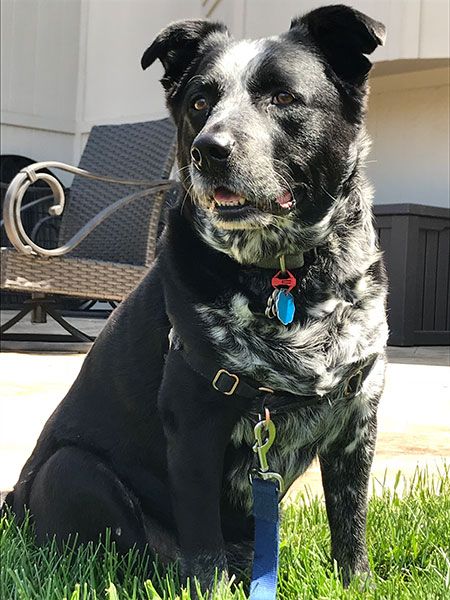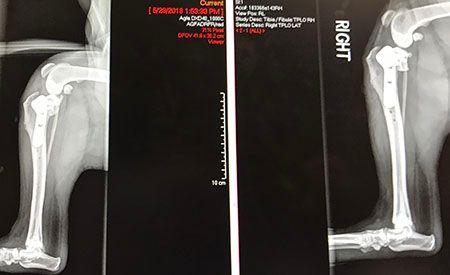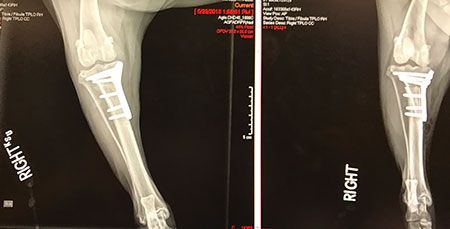A clients perspective on CCL repair
I learned first-hand this year how hard these injuries are for pets and their owners.
In March, my 6-and-a-half-year-old Australian cattle dog mix, Blitz, ruptured his right cranial cruciate ligament (CCL). Today, he's 14 weeks post-tibial plateau leveling osteotomy (TPLO) surgery. Here's my perspective on the caregiving and recovery process to help you know what concerns your clients might also face during this extensive repair process.
Blitz, the first night at home post-surgery. Photo courtesy of Katie James

The injury and initial assessment
I knew immediately that something was wrong. Blitz went from zooming excitedly around my apartment, to letting out a heart-wrenching series of cries. I was in the kitchen and didn't see what happened exactly, but he'd gotten excited and started running laps, from the front door to jumping on my bed down the hall and back.
Blitz's cries continued as he hopped out to the living room on three legs. Being in this industry, I've learned enough to recognize the signs of pain and knew it couldn't wait until morning when my regular veterinarian was open. Luckily, I have a 24-hour emergency hospital about four blocks away from my apartment.
The wait to be seen was a little more than 30 minutes but it felt much longer. Knowing my pet was in pain and that I couldn't do anything about it was awful. It didn't help that there was an overtired toddler in the waiting room who was shrieking and working Blitz up further. The veterinarian we saw told me it was one of the clearest examples of a CCL tear he'd ever seen. He didn't need radiographs to confirm it, just a physical examination. We were sent home with pain meds and instructions for rest and to call the surgery service in the morning.
Deciding on the next step
The first night post-injury was the worst. Blitz wasn't given any pain control while in the emergency hospital and I stayed up with him, willing the meds to take effect faster, once we got home. I was consumed with guilt. It was my fault. I just kept imagining how things would change and I felt like I'd ruined his life. I knew I shouldn't let him run like that, but at a stocky then-60 pounds, it was hard to stop him without just letting him barrel into me. I knew I shouldn't let him jump on the bed. I'd gotten a new, taller, mattress a few months earlier and had seen him not quite make it onto the bed once-A moment that had made me think, “I should look into getting bedside stairs.” I knew he needed to lose some weight, and I was trying to get the extra pounds off. In fact, we'd just gone running earlier that evening. (He has since lost some weight and is within 2 pounds of his goal weight.)
The next morning, I called my regular veterinarian and he confirmed that they don't perform TPLO procedures there. He recommended going to the emergency practice that we'd gone to or to call the Kansas State (K-State) University or University of Missouri veterinary schools.
I called K-State, a couple of different practices around the area and the emergency practice we'd been at the night before, where they didn't have a surgeon available for TPLO specifically for a month and a half. (How does that happen?) I was welcome to call a different branch though.
It was overwhelming. The emergency veterinarian had recommended TPLO, so that's what I asked each practice about. By the end of my calls, I had two more acronyms in my head to make a decision about. It was confusing, and since I'd done all my inquiries over the phone, I couldn't picture each procedure and why I'd go with one over the other. I was pretty set on TPLO from the start, so trying to picture something else was difficult. But I was given a super helpful resource from the American College of Veterinary Surgeons (ACVS) by our dvm360 and Fetch dvm360 conference medical director that showed me what each doctor had recommended. (It helped me so much that we worked with the ACVS to create a similar printable handout that can be downloaded from our site for clients.)
The team at K-State made me feel comfortable and they could get us in in two weeks, so I decided we'd drive the two hours to the veterinary school.
I live on the second floor of my apartment building and spent the next two weeks pre-surgery carrying Blitz up and down the stairs to go out. He's heavy and I was nervous every time that I'd slip and harm both of us-not to mention it was terrible for my back-but he wouldn't tolerate a sling, though I tried four different versions.
Time to fix Blitz!
The day of the surgery, both the veterinary student assigned to Blitz's case and the surgeon assessed Blitz and answered all of my questions. They reassured me that he'd be able to be a dog again after we came out the other side of this, which was a relief. The only thing that surprised me was how long Blitz would have to be activity-restricted-including stairs. It wasn't going to be hard to keep him still and resting. I'd either kennel rest him or keep him on a short leash sitting next to me, which he enjoys. But the stairs were going to be a problem.
I figured he wouldn't be able to do them for a while, but I wasn't anticipating it would be the full eight weeks until his next appointment. I'm fortunate to live near my parents, whose home only has two steps up, and they agreed to let us stay with them. (THANKS, MOM AND DAD!) I don't know how someone who doesn't have that option would manage this recovery process successfully. I was having back pain after only two weeks of lifting him-I can't imagine what it would have been like to do it for another eight to 12 weeks. No matter how much you try to lift with your knees and not your back, a dog is an odd shape and size to lift. (I feel you, veterinary team members.)
One of the things that I loved about K-State was that they'd monitor Blitz for a few days post-surgery, and “my” vet student called me twice a day with updates. It made me feel so much better knowing that a team of highly qualified caregivers was watching over him while he was the most fragile and I could pick him up after a few days.
Because I was at a veterinary school, I had the opportunity to enroll Blitz in a clinical trial as well. The study was investigating the efficacy of Fortetropin supplementation after TPLO surgery to prevent muscle atrophy, and perhaps to improve the rate of muscle mass increase after surgery or shorten the time to resolution of the lameness. All I had to do was feed Blitz the supplement and come back for rechecks, which included radiographs and ultrasound. It sounded simple enough, and if it would potentially help with his atrophy, I was all for it.
Back home and on the mend
The morning I picked Blitz up from surgery he'd been a little febrile, so we were sent home with antibiotics in addition to the two pain medications and the study supplement. I was really nervous loading him in and out of the car, but it all went smoothly.
I realized when we got home that his kennel, which is appropriately sized under normal circumstances, was too small to accommodate Blitz and his e-collar. Not that he was doing a lot of moving around at the moment, but once he was in, he wasn't going to be able to move around at all. The cone would get stuck on the bars of the kennel, and I didn't want him to be uncomfortable for the two weeks he had to wear the cone, so I turned back around after the two-hour drive home and went to the pet store to buy a great dane-sized kennel, which I've dubbed the “Puppy Palace” because it's so large for him sans-cone.
The first few days at home were rough. Blitz had no appetite, and taking multiple medications four times a day plus a protein powder was just not something he wanted to do. The antibiotic alone was four capsules at once four times a day. And they had to be taken with food. I tried everything to get him to eat: softening his food with warm broth, adding his favorite veggies, hiding the meds in peanut butter or cheese-even gently warmed canned food-to no avail. He did love the hardboiled egg I gave him out of exasperation. At least he ate something. I was having serious second thoughts about being able to continue participation in the clinical trial, no matter how much I wanted to help future TPLO patients.
The one saving grace is that my coworkers were more than understanding when I had to leave in the afternoon to give medication, and they were patient as I worked remotely in the afternoons until we were done with the meds. This is just one of perks of working in an industry where people understand what's going on, but not all of your clients will have such flexible and understanding employers.
Photo courtesy of Katie James

Blitz was an office dog for a day pre-surgery so I could watch him. He loved all the attention the dvm360 team gave him.
Once we got past the initial few days of inappetence, the recovery process went a lot smoother. Blitz tolerated the supplement well if I'd mix it into his favorite treat, peanut butter. I wouldn't say it was easy, but I wasn't having to force medication in him anymore, which was nice.
Photo courtesy of Katie James

On sunny days we'd go out and sit in the grass for a change of scenery.
We settled into a routine at my parents' house. If I wasn't home, Blitz would stay in his kennel. I wasn't sure how well this would work, because my parents have a dog of their own who has the run of the house and my mom is in and out of the house most days. I had a feeling Blitz would make it known that he didn't want to be in his kennel, but for the most part he just quietly sat and watched what was going on. When I was home, I'd put him on a leash and hook it under the leg of a chair or table so he couldn't wander. Then I'd sit right next to him, further cutting down on his want to wander.
Will this happen again?
I was probably overly cautious with the activity restriction, but I was constantly worried he'd overdo it or slip and reinjure something. Or blow the other knee. My parents' house has an area of wood floor that I couldn't avoid completely, and I'd make him carefully and slowly cross it when he needed to go out. In the back of my mind I was always thinking about his post-surgical knee, but also his good knee. Though I needed to be informed, within 30 seconds of seeing the technician and veterinarian that first night in the emergency practice, they'd both told me that their own dogs had ruptured the CCL in both of their knees. And did I know, they added, that, “The likelihood of him doing it again in the other knee is 40-60%?”
I did know it could happen, though those numbers are higher than I wish they'd be because I never want to do this again. The team at K-State further reminded me that it could happen again and gave me the same odds.
Even though I knew I'd followed the recovery instructions closely and had been super careful, I was nervous for the eight-week follow up. What if he had messed something up and I didn't know? He wasn't ever showing signs of pain or lameness, but I had a nagging thought. I needed to see that the radiographs looked good and have the veterinarian look at him. It, of course, was all fine and they said he was doing great.
Blitz's radiographs: eight-week checkup on the left; immediately post surgery on right. Photo courtesy of Katie James

Photo courtesy of Katie James

Blitz's radiographs: eight-week checkup on the left; immediately post surgery on right.After the eight-week checkup, we both felt some relief because Blitz was cleared to begin gradually easing back into walking for reasons other than to go to the bathroom. I'd essentially placed myself on house arrest because I hated to leave Blitz kenneled day and night, so I'd been tied to the first floor of my parents' house mostly. Yes, I'd leave for work or to meet friends on the weekend, but as much as I could I'd sit in the living room and keep him company. Even so, it was great to get out of the house for longer periods of time. Prior to his injury, we'd go on a several-mile-long walk after I got off of work each evening, and we both missed it.
Moving cautiously forward
Between the eight- and 12-week follow ups I thought it'd be hard to keep Blitz from going too far too fast because he felt better, but he was fine with it. I gradually let him off the leash a bit in the house when I could gate him in a single room. Now, after the 12-week final follow-up, we're going on longer walks again to build up his endurance slowly, and he's got the run of the first floor of the house after work. I still haven't quite worked up the courage to turn him loose in the backyard because I know he'll all-out sprint, and it gives me a little bit of post-traumatic stress just thinking about it. We'll get there though.
I'll probably never know if Blitz was on the Fortetropin or if he'd received the placebo, but his muscle atrophy-and, boy, did his leg muscles atrophy in the two weeks before and two weeks after surgery when he wasn't using his leg much-is almost entirely resolved and he hasn't had a visible limp in weeks. I'm hopeful that he was on the active supplement and that it works. How cool would that be for future patients?
While this experience was traumatic, and I don't want to go through it again (fingers crossed he'll be one of the ones who doesn't rupture both), I do think the bond I have with Blitz has become stronger because we've spent so much time together. A small bright spot in this journey.
